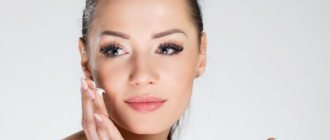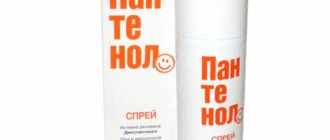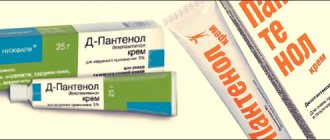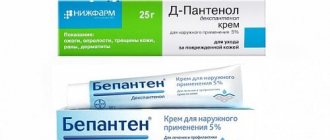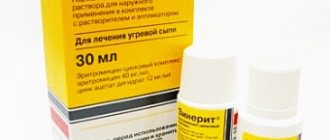Panthenol cream and spray are used to eliminate burns, wounds, and diaper rash. In cosmetology, the product is widely used to combat wrinkles formed as a result of lack of moisture. Women use the product to rejuvenate the skin.
The rules for using Panthenol vary depending on skin type: dry, oily, normal. The product has some contraindications: for example, a tendency to allergies, exacerbation of herpes, children under 18 years of age, kidney pathologies, hypervitaminosis and increased sensitivity to sunlight.
Panthenol - what is it?
Panthenol, or pantothenic acid
– water-soluble vitamin B5 (dexpanthenol) with low molecular weight and high ability to penetrate into the deep layers of the skin.
Pantothenic acid was discovered in the 30s of the 20th century and almost immediately found application in pharmacology due to its pronounced anti-inflammatory, regenerating, and soothing properties. The ability to accelerate tissue renewal, maintain their firmness and elasticity, smooth out wrinkles, soften and moisturize the epidermis has allowed vitamin B5 to take first place among components for facial and body skin care. Today, panthenol for the face is one of the key components and helps solve several skin problems at once.
Types of dosage forms, composition
D-Panthenol is available in the form of ointment and cream. 1 g of both forms contains 50 mg of dexpanthenol.
D-Panthenol cream has a white color, a uniform structure, and no pungent odor. It is packaged in tubes of 25 or 50 g, which are sold in boxes with instructions. Additional ingredients include propylene glycol, methyl parahydroxy- and propyl parahydroxybenzoate, macrogol cetostearate, cetostearyl alcohol, paraffin, petroleum jelly, sodium hydrogen phosphate dodecahydrate, potassium dihydrogen phosphate, purified water.
D-Panthenol ointment has a white color with a yellowish tint, a thicker structure and a faint odor. It is packaged in 30 g aluminum tubes, which are placed in a box complete with instructions. In addition to dexpanthenol, it contains glycerin, lanolin, petroleum jelly, liquid and solid paraffin, stearyl and cetyl alcohols, and water.
Where is panthenol used?
- In cosmetics, Panthenol in cosmetics has earned a reputation as a powerful external restorative, healing, moisturizing agent. In cosmetic formulas, vitamin B5 is found in the form of pantothenic acid derivatives: D- and L-panthenols. Often used in soothing products for sensitive, dry, oily and problematic facial skin, as well as in after-sun formulas. Its ability to stimulate the synthesis of collagen and elastin, reduce facial wrinkles, and smooth out skin texture allows the use of panthenol as part of anti-aging corrective care. Shampoos, balms and masks with provitamin B5 for hair improve hair structure, stimulate growth, prevent irritation and dryness of the scalp.
- In cosmetology Since the key function of dexpanthenol is the regeneration of the skin, in cosmetology products based on it are used mainly after traumatic aesthetic procedures, for example, chemical peels, photoepilation, laser resurfacing, during which the integrity of the epidermal layer of the skin is damaged. Panthenol-containing creams, gels, masks help quickly soothe and moisturize damaged skin, relieve swelling and swelling of tissues, shorten the rehabilitation period and prevent complications.
How to apply Panthenol products to your face for acne
- Applying the cream to the face should only be done in a subtle and targeted way to treat acne.
- The cream or ointment should be used 2 times a day, morning and evening, after cleansing and moisturizing the skin of the face to improve the effect of using Panthenol.
- It is also recommended to apply the spray only to moisturized and cleansed skin half an hour after such a facial cleansing procedure, spraying the spray onto the most affected areas of the facial skin. Such procedures should be performed 3 times a day.
The most suitable remedy for quickly removing swelling and the pimple itself is salicylic-zinc paste!
Properties of panthenol for face and body skin
Provitamin B5 has a wide range of important functions applicable in cosmetology. We will analyze the beneficial properties of panthenol for the skin of the face and body and tell you whether the substance can cause harm.
Benefit
- Promotes accelerated regeneration of skin cells and mucous tissues due to the synthesis of the most important energy enzyme coenzyme A, restores epidermal protective functions.
- Soothes, relieves irritation and redness, has an anti-inflammatory effect.
- Quickly restores a feeling of comfort to the skin after prolonged sun exposure.
- Has a rejuvenating effect: fights wrinkles, decreased skin turgor. Has a slight lifting effect, stimulates the production of natural collagen and elastin.
- Moisturizes, softens, protects the skin from dehydration, minimizes and prevents flaking.
- Prevents photoaging: loss of elasticity, hyperkeratosis, dehydration wrinkles.
- Strengthens the walls of blood vessels, prevents the appearance of rosacea.
- Strengthens skin immunity, normalizes cellular metabolism.
- Stimulates hair and nail growth.
Harm
It is impossible to damage the skin with panthenol, since the substance is non-toxic and does not cause allergic reactions, dryness or irritation. On the contrary, it is recommended to use a product based on it against all of the listed skin damage. It is not recommended to use products with vitamin B5 if you are intolerant to it.
Panthenol - cream, ointment against wrinkles around the eyes: application
The skin around the eyes is especially delicate. Women with dry, tired skin are more likely to suffer from wrinkles in this area. They show these age-related changes faster. Despite the healing properties of Panthenol, it is not able to cope with deep expression wrinkles. A temporary effect may appear immediately after applying the cream or ointment, but it is not long-lasting. To achieve this, use ointment (twice a week) if you have completely dry eyelid skin. Or apply cream to the area near the eyes if you have dry or normal skin type.
Using Panthenol for wrinkles around the eyes
Indications for the use of cosmetics with panthenol
Cosmetics with vitamin B5 are suitable for any skin type and satisfy its basic care needs. Let's look at the effect the substance has on the epidermis and how to use panthenol.
- Dry skin Panthenol helps restore comfort to even the driest skin of the face and body: it moisturizes tissues for a long time, softens, makes the epidermis elastic and nourished.
- Peeling on the face and body After using a product with panthenol, the skin becomes smoother, softer, the rough stratum corneum of the epidermis softens, peeling and the feeling of tightness disappear.
- Sunburn Panthenol is the first and most effective assistant for sunburn. An after-sun cream based on it instantly soothes and moisturizes hot skin, has a trophic effect, relieves pain, and initiates tissue restoration processes.
- The first signs of aging As part of an anti-age beauty routine, the nutrient also plays an important role: it prevents a decrease in skin turgor, smoothes out creases of various origins. Can be used to care for the eye area: reduces wrinkles, dark circles, restores and protects thin, dry epidermis.
- Redness and irritation of the skin The basis of formulas for the care of reactive and hypersensitive skin effectively combats the burning sensation, soothes the epidermis, restores its hydrolipid barrier, eliminates swelling and redness. It helps well with razor irritation, so it is often found in aftershave lotions.
- Signs of acne Vitamin B5 heals damage to the skin, for example, when trying to get rid of acne or blackheads on your own. Also helps to moisturize the skin due to excessive use of drying alcohol-based products.
Panthenol for acne reviews
Reviews from dermatologists
The use of Panthenol for the treatment of acne is, of course, not the most important purpose and function of the drug, which is more designed to treat skin diseases of a slightly different form and category. However, if the patient is ready to wait and regularly use Panthenol for acne 2 times a day for 2 months, then the result from its use can be much better and safer than the use of any other acne remedy Dermatologist: Oksana Viktorovich.
In general, patients should be warned against confusion in Panthenol acne products, since there are anti-inflammatory drugs in the form of cream, ointment or lotion and Panthenol, intended for the treatment of sunburn on the body and face. Combine the use of these products or use a cosmetic anti-inflammatory drug for burns or anti-burn for acne is strictly not recommended Dermatologist: Victor Zhemyakin.
Patient reviews
Yulia, 19 years old, Krasnodar: I used the spray to treat acne on my face for 2.5 months. I’ll tell you the truth, the first month of treatment gave me only an almost insignificant result, and I recorded a decrease in the number of acne and pimples only after 5 weeks of use means So, I think not everyone has enough patience for this method of treatment.
Victoria, 20 years old, St. Petersburg: Pantonol ointment for acne was prescribed to me by my attending physician, a dermatologist, since the skin of my face was very flaky and was constantly dry and tight, which caused some discomfort and uncertainty. The dryness on my face went away after using the ointment for 3 weeks
Oleg, 28 years old, Kiev: I didn’t think that Panthenol was generally intended for treating acne. Personally, I only knew that the cream could be used in case of burns, herpes or deep cuts. Panthenol itself is a useful thing, I think it should be in every first aid kit, especially if It turns out that the drug also treats acne.
Features of using panthenol for different skin types
- For oily skin The component is contained in light non-comedogenic gels, fluids, creams for oily problem skin, prevents tissue dehydration and fights its consequences: dryness, keratosis, peeling, irritation.
- For dry skin Found in many moisturizing cosmetic product formulas. Used in baby skin care products. Nourishes, moisturizes, protects the epidermis, combines well with other emollients and hydrofixatives, such as glycerin and hyaluronic acid.
- For normal The normal type is highly susceptible to almost all caring components in cosmetics. If your base cream for normal skin contains panthenol, then use it according to the instructions for use.
- For combination The combination type combines the dry area of the U-zone and the T-zone, in which the sebaceous glands are most active. Since panthenol does not clog pores, moisturizes, softens, and restores the epidermis, it is widely used in the care of this skin type.
Side effects
Any product, not only medicinal, but also cosmetic, requires compliance with the instructions for use. Uncontrolled use of drugs in violation of dosages will lead to negative results.
Side effects:
- Allergic rash;
- Redness of the facial skin;
- The appearance of local edema;
- Excessive dryness of the skin;
- The occurrence of itching;
- Peeling;
- The appearance of indigestion.
It is difficult to get rid of the negative consequences and thorough treatment will be required. When the first unpleasant symptoms appear, it is recommended to immediately stop using panthenol. If itching, redness and flushing persist, you may need to take an antihistamine. You should not self-medicate and, if necessary, you should visit a doctor.
Forms of release of cosmetics with panthenol
Depending on the type and needs of the skin, there are several formats of cosmetic products containing panthenol. For oily and combination skin, choose water-based products with light textures - gels, serums, fluids, balms. For dry skin, nourishing products containing lipid-restoring formulas and oils, such as rich creams, are suitable.
Often panthenol can be found in the base of foundations or correctors, lipsticks or balms, for example, in the composition of Cicaplast restoring lip barrier balm. Shampoos, conditioners, and masks with panthenol are produced for hair.
Effect on the skin
Well, for starters, there is no need to confuse the different properties of the drugs that are the main active ingredient!
| A drug | Impact | Result | Application area |
| Dexpanthenol | Strengthening collagen fibers | Restoring the protective qualities of the skin | Pharmacology |
| Panthenol | Impact on metabolic processes | Acceleration of recovery processes | Cosmetology, pharmacology |
- Dexpanthenol is a drug that “lives” exclusively in pharmacology in the form of an ointment.
- Panthenol is more often used in various creams, masks and foams in the beauty industry.
Varieties and composition
All produced forms of Panthenol include D-panthenol, a synthetic derivative of vitamin B5, or panthenol, its analogue.
To enhance the effect, many manufacturers add aloe vera extract, allantoin, and vitamin E as additional components.
It is better to choose facial preparations with these caring components, because they add positive properties to the beneficial properties of the drug:
- hydration;
- anti-inflammatory effect;
- antioxidant properties.
This certainly won't make it any worse.
There are 4 types of industrial versions of Panthenol:
| View | Package | Consistency | Compound | price, rub. |
| Cream | Tube | Soft substance | Cetanol, ceteatrin | from 350 |
| Spray | Spray bottle | Aerosol | Alcohol, mineral oil, wax | from 300 |
| Ointment 5% | Tube | Jelly-like fatty substance | Vaseline, paraffin, lanolin | from 350 |
| Milk | Soft tube without dispenser | Liquid emulsion | Dimethicone, liquid paraffin, propylene glycol | from 120 |
Is there any effect on wrinkles?
We immediately assume that Panthenol will not be able to fight serious age-related changes, so there is no point in using it at 40+, wrinkles will not go away.
In the initial stages of aging, Panthenol will help retain moisture in skin cells, smooth out fine wrinkles and improve the color and turgor of the skin, making it smooth and silky.
Just don’t forget that all this is possible at the age of 25+, when all the sad processes are just beginning. Unfortunately, at this time we don’t think at all about the safety of our face.
I think that at 30 you can also try. Course of treatment: 7 days with Panthenol cream, then 2 weeks without it. Then you can repeat the treatment week.
Indications and contraindications
Main indications for use:
- skin restoration after chemical peels, burns;
- increased skin dryness;
- elimination of wrinkles and skin rejuvenation.
Manufacturers recommend Panthenol for the treatment of acne, but I can’t check this, since my problems with acne are already a thing of the past, and I haven’t taken anyone’s word for a long time.
With contraindications everything is as usual:
- allergy to components;
- age under 18 years;
- herpes;
- pregnancy and breastfeeding;
- colds, fever.
To avoid an allergic reaction, before use it is better to do a Panthenol test on the bend of your elbow or on your wrist.
